Why Is My Meatloaf Pink Inside? Understanding the Causes
Meatloaf is a beloved comfort food that many people enjoy making at home. However, it can be concerning when you slice into your meatloaf only to find that it's still pink inside, even after you've cooked it for the recommended time. Let's delve into the reasons why your meatloaf might be pink inside and how to ensure it’s safe to eat.
The Science Behind Pink Meatloaf
1. Myoglobin and Meat Color
One of the primary reasons meat can appear pink is due to a protein called myoglobin. Myoglobin stores oxygen in muscle cells, and its presence can affect the color of meat. When meat is heated, myoglobin undergoes chemical changes, typically turning brown or gray. However, certain conditions can cause myoglobin to retain a pink hue.
2. Nitrates and Nitrites
Another common reason for pink meatloaf is the presence of nitrates or nitrites. These compounds are often found in processed meats like bacon and ham but can also occur in homemade meatloaf if you add ingredients such as celery, which naturally contains nitrates. These substances can prevent myoglobin from fully changing color, resulting in a pink appearance even when the meat is fully cooked.
3. Cooking Temperature
The internal temperature of the meatloaf is a crucial factor in determining its doneness. Meatloaf should reach an internal temperature of 160°F (71°C) to be safe to eat. Using a meat thermometer is the most reliable way to check this. If the meatloaf is undercooked, it can remain pink inside.
4. pH Levels
The acidity or alkalinity of the ingredients in your meatloaf can also affect its color. Ingredients with higher pH levels, such as baking soda, can cause meat to stay pink. Conversely, acidic ingredients like vinegar or lemon juice can make meat turn brown more quickly.

why is my meatloaf pink inside
Ensuring Your Meatloaf is Safe to Eat
1. Use a Meat Thermometer
The best way to ensure your meatloaf is cooked thoroughly is to use a meat thermometer. Insert the thermometer into the thickest part of the meatloaf, making sure it reaches 160°F (71°C). This temperature ensures that harmful bacteria are destroyed and your meatloaf is safe to eat.
2. Check the Ingredients
Be mindful of the ingredients you use. If you include ingredients high in nitrates or nitrites, expect a pinker meatloaf. While this isn’t necessarily harmful, knowing the cause can alleviate concerns about undercooking.
3. Allow Resting Time
Let your meatloaf rest for about 10-15 minutes after removing it from the oven. This rest period allows the juices to redistribute throughout the meatloaf, making it easier to slice and ensuring even cooking.
4. Avoid Overmixing
Overmixing your meatloaf mixture can lead to a denser texture, which can affect how it cooks. Mix just until the ingredients are combined to avoid this issue.
Common Myths About Pink Meatloaf
1. Pink Meatloaf is Always Undercooked
This is a common misconception. As discussed, the pink color can be due to various factors other than undercooking, such as nitrates, nitrites, and myoglobin.
2. Cooking Longer Will Remove Pinkness
While cooking longer might change the color, it can also dry out your meatloaf. Instead, focus on reaching the correct internal temperature.
3. Pink Meat is Unsafe
Pink meat is not necessarily unsafe as long as it has reached the recommended internal temperature. The color is influenced by several factors that do not relate to food safety.

why is my meatloaf pink inside
Conclusion
A pink center in your meatloaf can be surprising, but it doesn't always mean it's undercooked. By understanding the science behind meat color and using a meat thermometer to check for doneness, you can ensure your meatloaf is both delicious and safe to eat. Whether it’s myoglobin, nitrates, or the cooking process itself, several factors contribute to this phenomenon. Embrace these insights to enjoy perfect meatloaf every time.